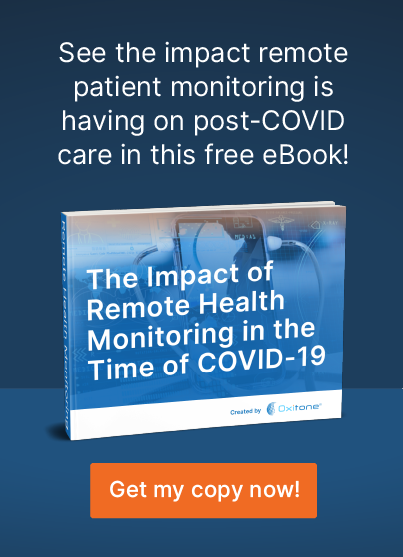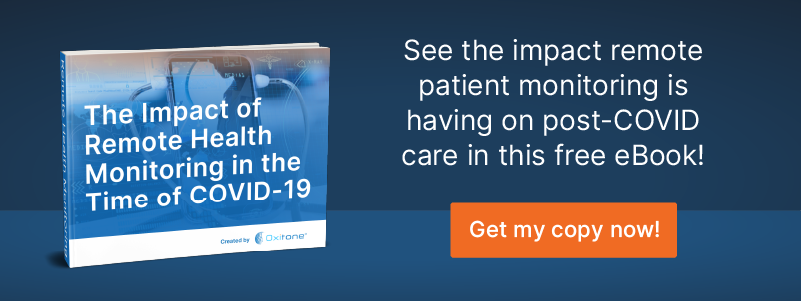Keeping nursing homes fully staffed with qualified healthcare professionals is a significant challenge. It’s been a problem for years, but the COVID pandemic has made it a full-blown crisis for many providers.
A June 2021 study from the American Health Care Associations and National Center for Assisted Living reported that an astonishing 94% of nursing homes had a staff shortage. More than 50% of providers say that they lost key staff members during the pandemic.
To combat staffing shortages, many nursing homes have turned to continuous remote patient monitoring (CRPM) to help provide critical care for patients, monitor patient conditions, and answer the question of how to improve nursing home care.
Nursing home care has always been a challenge due to the number of patients dealing with chronic conditions. Providers know the 80/20 rule all too well: overall, 80% of healthcare expenses come from just 20% of patients, those with chronic conditions. These are the patients who are over-represented in nursing homes.
New research shows that it may be even higher than 80%. Patients with chronic conditions need greater monitoring and care. CRPM can provide personalized, precise, and pre-emptive interventions to help with patient monitoring and management, reduce costs, and lead to better patient outcomes
The Benefits of CRPM in Nursing Home Care
CRPM provides several benefits in nursing home care, though probably none bigger than predicting exacerbations for chronic conditions.
CRPM devices, such as the Oxitone 1000M, provide real-time monitoring to detect even slight changes in patient conditions. Real-time monitoring coupled with artificial intelligence (AI) can better detect the signs that lead to significant problems. CRPM devices take continuous readings, which help provide more accurate baselines. When anomalies occur, the AI can evaluate the impact of the changes and compare them to previous data to determine whether they should be flagged for follow-up for healthcare providers. The trendlines and underlying data are available to providers to make better clinical assessments.
In a traditional nursing home setting, nurses may take vital signs a few times a day (or a few times an hour, depending on a patient’s condition). Activity, medication, and other things can impact these readings. Even if all the readings are accurate, it can still create an inaccurate picture of a patient’s baseline or condition against that baseline, due to there being so few data points. CRPM provides thousands of data points for better monitoring.
All of this enables healthcare providers to monitor more patients despite any staffing issues. In case of a change that may indicate an oncoming exacerbation, healthcare providers get an earlier warning. This can help prevent more serious or life-threatening events from occurring, leading to better treatment options and avoiding trips to the emergency room.
Caregivers trying to figure out how to improve nursing home care have learned that CRPM can provide better patient outcomes and helps save on overall healthcare costs.
Medicare, Medicaid, and CRPM
A 2020 overhaul of CPT codes 99453, 99454, 99457, and 99458 expanded the use of telehealth and remote monitoring. This overhaul clarified reimbursement rules and made it easier for physicians and healthcare providers to use remote patient monitoring. According to the Center for Connected Health Policy, a program under the Public Health Institute, certain types of remote patient monitoring are now accepted for reimbursement by twenty-six state Medicaid providers.
Many private insurance carriers are also providing reimbursement for CRPM.
Besides lowering patient care costs and improving outcomes, remote patient monitoring can also be lucrative for caregivers to offset the high costs of providing quality nursing home care.
The Oxitone 100M Provide Real-Time Clinical Care Data
The Oxitone 1000M provides real-time data for continuous monitoring of:
- SpO2
- Pulse rate
- Heart rate variability (physiological stress)
- Activity
- Skin temperature
- Sleep apnea and disorders
- Respiratory rate
The Oxitone 1000M also provides one-click data for sleep patterns, physiological stress, hypoxia index, behavioral data, and clinical reposts. It provides dynamic health status baselines for:
- COVID-19 screening
- COPD
- CHF
- Sleep apnea
- Occupational health
- Pain management
The Oxitone 1000M provides smart notifications with five different verification levels to virtually eliminate false alerts.
The World’s First FDA-Cleared Wrist-Sensor
The Oxitone 1000M is the world’s first FDA-cleared wrist-sensor pulse oximetry monitor. Unlike other devices, it does not require a fingertip probe. It looks like many of the smartwatch products on the market today, so patients feel comfortable wearing them and aren’t inhibited in their movements. Each unit sports a long-life rechargeable battery and features Bluetooth connectivity to provide real-time data.
Here at Oxitone, we boost value-based healthcare by delivering extraordinary patient, clinical, and economical outcomes at reduced medical utilization and cost. Patients need a prompt response to emergencies. Physicians need an easy and timely follow-up with patients. Our mission is to transform chronic disease management and help save lives worldwide.
Let’s save lives together! To see how we help remote patient monitoring companies and physicians improve the management and care of high-risk patients, contact us today!


